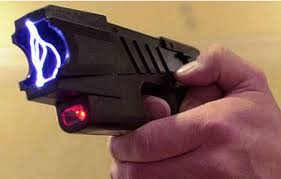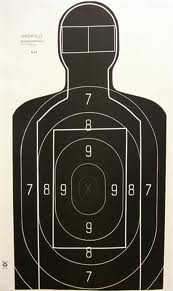When I started to contemplate what I was going to write for this day of blogging action on the use of tasers… i.e., “electrocution” to control and/or stop what are considered dangerous, anti-social behaviors… what stood out in the forefront of my mind was that in the past, electrocution (called Electroconvulsive Therapy), was also widely used for a similar purpose: as an approved, standard medical/psychiatric procedure for “supposed” dangerous and anti-social behaviors deemed to be mental illnesses, which included homosexuality and political dissent.
As a police officer (in Canada), my initial point of view is that I will use whatever level of force I deem necessary, when dealing with a violent criminal suspect, to protect the life of others and/or prevent bodily harm, but more importantly… to ensure that I go home to my family at the end of my shift! Presenting my wife and son with a Canadian flag and a hug or handshake at the end of a memorial service in my honor, just isn’t a life-affirming ambition of mine. With that being said, the police organization I work for, like most if not all police services in North America, are mandated and trained to follow some sort of “use of force continuum model”, which dictates what level of force is to be used in a given situation.

However, what this type of model does not show are the individual, environmental and societal factors that may influence how an officer will react to a given situation or person. It does not consider what are the beliefs, values and more importantly, the prejudices that may spur an individual officer’s action or reaction, to a particular situation or person. For example, for years my service used a black silhouetted target during firearms training and requalification, similar to the one below:
What are the psychological effects of always viewing an image like this one, which resembles a Black male, as a serious threat to be dealt with by lethal force? How does this training aid, which a police officer will fire numerous rounds of bullets at every year, for a number of years… how does it shape one’s perception and the automatic-like reaction to situations involving a person who is represented like this image?
Now the fact is that while thousands of people have been tasered by law enforcement officers in North America, since it became a standard use of force option, only a very small percentage of deaths have been attributed to its use. According to truthnottasers, “at least 405 people have died in North America proximal to taser use since 2001.” Further it states that: “the taser has been identified as either a cause or contributing factor in at least 50 of the deaths, according to Amnesty International (Dec. 16/08).” This is not meant to defend the use of tasers… quite the opposite, in fact it raises some serious questions about its continued use.
First, let me state that perceiving the number of deaths caused by the use of tasers as a statistical exercise, when compared with the total number of times it has been used, minimizes the sanctity of human life. Even 1 death is troubling… much less 405 since 2001!
Second, according to all the use of force continuum models, tasers are supposed to be a non-lethal use of force option. Then why have they resulted in lethal outcomes… and specifically… why for so many Black men, women and children!?
Third, in regards to Black people, are the inordinate number of deaths by tasers a result of it’s more frequent use against us? AND if this is the case, is it because we seen as being more dangerous, anti-social and aggressive by those of the dominant culture, specifically by those given the authority to keep the peace? Also, has the training and training aids used by police academies like the target above, cause officers to subconsciously use non-lethal use of force equipment in a lethal manner, when dealing with Black men, women and children? Or could it be something more… like physiologically it has a more lethal effect on our being?
My organization’s policy is that only supervisors are trained and authorized to carry and deploy a taser. Their rational is that an experienced officer, with proven decision-making abilities, will make better judgments in determining when it is to be used. So far, we have few incidents of taser use and there has only been 1 taser-related death that is currently being investigated, since we began using tasers in 2003. Still, it’s 1 death too many!
On this day throughout the afrosphere, Black bloggers throughout the world are bringing much needed attention to this issue. Now to be clear, I am not personally calling for a ban on the use of tasers by police officers. My position is that any and all non-lethal use of force options that I am able to utilize, provides an increased opportunity for everyone to go home at the end of an incident… me, the accused, victims, witnesses, bystanders, etc. However, we need to address… once again… why members of the Black community are more likely to be killed by police action than other members of this society. Claiming that “it’s just a coincidence”, or projecting an attitude that “well shit happens”, is no longer an acceptable answer. Within a historical context, there are too many “coincidences” and instances of “shit happening” to us where we end up dead!
So a review of training standards, as well as organizational policies; more medical/scientific research on the effects of tasers… particularly on members of the Black community; a consideration of societal expectations; more law enforcement and community partnerships; continued grassroots advocacy and a commitment to individual responsibility, are some of the issues which needs to be addressed, in a concerted effort, to eliminate the unwarranted and unjustified deaths that is resulting from the pre-trial electrocution of Black children, women and men by tasers.
Here is an online petition to the U.S. Congress, calling for public hearings on the use of tasers:
Taser Torture in America – A Call for Congressional Hearings



I signed the Petition. Great job.
Your post in support of the Day of Blogging for Justice is outstanding. It is the best that I’ve read so far in my travels thru cyberspace. Your analysis on the use of force continuum is right on target.
I invite your blog readers to see what I had to say about taser torture in America and sign online petition seeking congressional hearings.
peace, Villager
Thanks Villager & Eddie.
Your posts are also thought-provoking and insightful. I recommend that everyone visits your blogs to get more perspectives on this issue.
Blessings!
YOUR BLOG WAS VERY INSIGHTFUL AND I WAS HAPPY TO READ IT FROM A POLICE OFFICER’S VIEW AND THE TRAINING THAT YOU ARE GIVEN.
Excellent analysis of how racial conditioning affects us all.
I agree that even one death is too many.
Tasers are like cell phones: didn’t we get along just fine without them? And if you take an unsparing look at them, are they helping or hurting?
We don’t no more trouble!!
Hello, I can’t understand how to add your blog in my rss reader
————————
sponsored link: http://semev.ru/
Terrific article! One of the best discussions of this topic I’ve read!